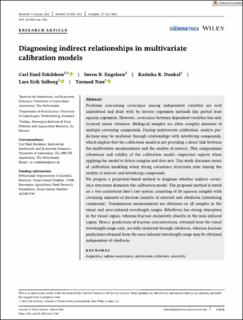| dc.description.abstract | Problems concerning covariance among independent variables are well understood and dealt with by inverse regression methods like partial least squares regression. However, covariance between dependent variables has only received minor attention. Biological samples are often complex mixtures of multiple covarying compounds. During multivariate calibration, analyte predictions may be mediated through relationships with interfering compounds, which implies that the calibration model is not providing a direct link between the multivariate measurements and the analyte of interest. This compromises robustness and validity of the calibration model—important aspects when applying the model to future samples and data sets. This study discusses issues of calibration modeling when strong covariance structures exist among the analyte of interest and interfering compounds. We propose a projection-based method to diagnose whether indirect covariance structures dominate the calibration model. The proposed method is tested on a two-constituent Beer's law system consisting of 20 aqueous samples with covarying amounts of fructose (analyte of interest) and riboflavin (interfering compound). Transmission measurements are obtained on all samples in the visual and near-infrared wavelength ranges. Riboflavin has strong absorption in the visual region, whereas fructose exclusively absorbs in the near-infrared region. Hence, predictions of fructose concentrations, obtained from the visual wavelength range only, are fully mediated through riboflavin, whereas fructose predictions obtained from the near-infrared wavelength range may be obtained independent of riboflavin. | |
